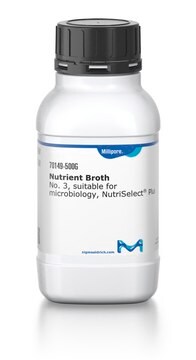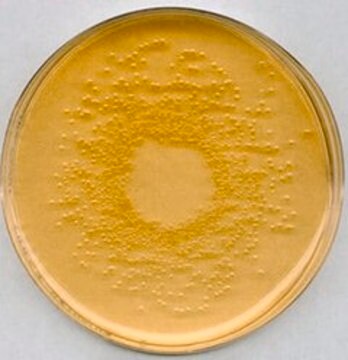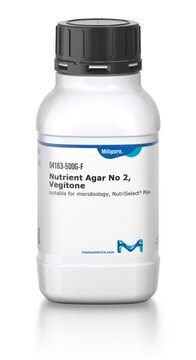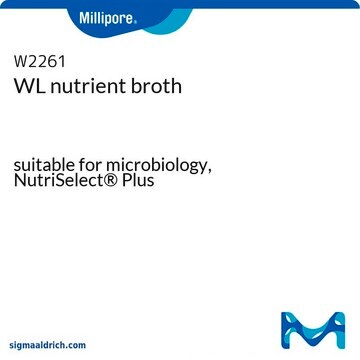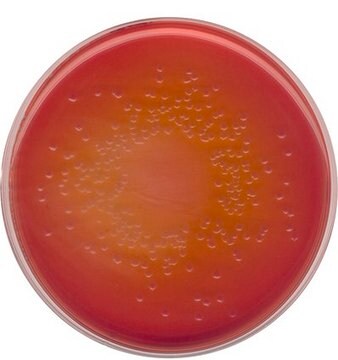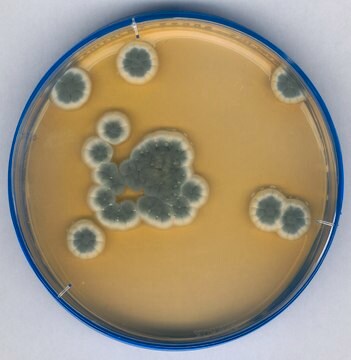N7519
Nutrient broth
Microbiologically tested, NutriSelect® Basic
Se connecterpour consulter vos tarifs contractuels et ceux de votre entreprise/organisme
About This Item
Code UNSPSC :
41171607
Nomenclature NACRES :
NA.74
Produits recommandés
Niveau de qualité
Stérilité
non-sterile
Forme
powder
Composition
Beef extract, 3.0 g/L
Peptone, 5.00 g/L
Fabricant/nom de marque
NutriSelect® Basic
Technique(s)
microbiological culture: suitable
Application(s)
bioburden testing
environmental
food and beverages
life science and biopharma
water monitoring
Adéquation
bacteria
Catégories apparentées
Application
Nutrient broth has been used:
- for culturing Azospirillum brasilense
- for reconstitution of freeze dried Staphylococcus aureus culture
- for culturing Pseudomonas aeruginosa NCIMB 8626
Variante de formule
With beef extract and peptone.
Notes préparatoires
Solve 8 g in 1 litre distilled water. Autoclave 15 minutes at 121°C.
Note de bas de page
We offer two media types: the superior granulated GranuCult® and the cost-efficient powdered NutriSelect® culture media, depending on your needs.
The designations basic, plus, or prime are added to indicate the quality control level, from basic quality control to standard QC plus to prime for full regulatory compliance.
The designations basic, plus, or prime are added to indicate the quality control level, from basic quality control to standard QC plus to prime for full regulatory compliance.
Informations légales
GRANUCULT is a registered trademark of Merck KGaA, Darmstadt, Germany
NutriSelect is a registered trademark of Merck KGaA, Darmstadt, Germany
Code de la classe de stockage
11 - Combustible Solids
Classe de danger pour l'eau (WGK)
WGK 3
Point d'éclair (°F)
Not applicable
Point d'éclair (°C)
Not applicable
Faites votre choix parmi les versions les plus récentes :
Déjà en possession de ce produit ?
Retrouvez la documentation relative aux produits que vous avez récemment achetés dans la Bibliothèque de documents.
Les clients ont également consulté
Incorporation and controlled release of a hydrophilic antibiotic using poly (lactide-co-glycolide)-based electrospun nanofibrous scaffolds
Kim K, et al.
Journal of Controlled Release : Official Journal of the Controlled Release Society, 98(1), 47-56 (2004)
Activity of acetyl-CoA carboxylase is not directly linked to accumulation of lipids when Chlorella vulgaris is co-immobilised with Azospirillum brasilense in alginate under autotrophic and heterotrophic conditions
Leyva LA, et al.
Annals of Microbiology, 65(1), 339-349 (2015)
Michele E Barbour et al.
International journal of nanomedicine, 8, 3507-3519 (2013-10-05)
Chlorhexidine (CHX) is an antimicrobial agent that is efficacious against gram-negative and -positive bacteria and yeasts. Its mechanism of action is based on cell membrane disruption and, as such, it does not promote the development of bacterial resistance, which is
Oskar A Palacios et al.
Microbial ecology, 77(4), 980-992 (2018-11-07)
The effect of three different nutritional conditions during the initial 12 h of interaction between the microalgae Chlorella sorokiniana UTEX 2714 and the plant growth-promoting bacterium Azospirillum brasilense Cd on formation of synthetic mutualism was assessed by changes in population growth
Beatriz Meza et al.
Research in microbiology, 166(2), 72-83 (2015-01-03)
Accumulation of intracellular ammonium and activities of the enzymes glutamine synthetase (GS) and glutamate dehydrogenase (GDH) were measured when the microalgae Chlorella vulgaris was immobilized in alginate with either of two wild type strains of Azospirillum brasilense or their corresponding
Notre équipe de scientifiques dispose d'une expérience dans tous les secteurs de la recherche, notamment en sciences de la vie, science des matériaux, synthèse chimique, chromatographie, analyse et dans de nombreux autres domaines..
Contacter notre Service technique
